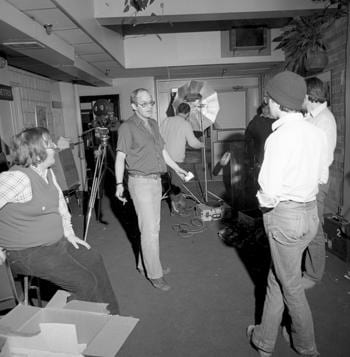In February 1981, young filmmakers Harry Sutherland, Gordon Keith and Jack Lemmon were wondering what to do with the hours of 16mm film they had shot documenting the 1980 Toronto civic election.
They had hoped to tell the story of how gay activist George Hislop, running partially on a gay rights platform and with the support of then-mayor John Sewell, became Toronto’s first openly gay city alderman. But both men were defeated at the polls after the Toronto Police Association campaigned against them. It was a huge disappointment for gay people and left Sutherland and his colleagues without much of a dénouement for their film.
Then, on Feb 5, 1981, as the three were working to salvage their project, Toronto police launched simultaneous raids against four of the city’s bathhouses. Flush with credit earned only on merit of mistaken identity — the protagonists in this story are not related to famous actors Jack Lemmon and Donald Sutherland — they took to the streets, recording the events of that night and the subsequent riots. The result is a documentary film called Track Two. It is one of the most complete records of the events, and might be the only moving picture version. In fact it may be one of the only film accounts of the fundamental changes then unfolding within the gay liberation movement across the Western world.
“What became very apparent as we made this film is that the Toronto police department had a plan to close down the gay community,” says Sutherland in a 2008 video interview. “The first part of that was closing down the bathhouses. As the story unfolded, it all became obvious that the police department was responsible to nobody in Toronto. It was actually responsible to the Ontario Government.”
Appearing in Track Two are Hislop, Sewell, Laurier Lapierre, Gerald Hannon, Douglas Chambers, John Burt, Chris Brearchell, Brent Hawkes and many others.
The musical score is by Carole Pope and Kevan Staples.
The film premiered at Toronto’s Bloor Cinema on July 1, 1982. It was a full house for opening night andTrack Two was released in Cineplex’s 16mm theatres across Ontario, but the film did not ultimately go on to achieve commercial success. The producers were left more than $40,000 in debt.
Thirty years later, only two 16mm prints are known to remain: one in the National Archives and one, badly degraded, in the Quebec Archives. But this year, Pink Triangle Press executive director Ken Popert, who appears in the film, spearheaded the work’s rebirth. He tracked down the producers, got rights permission to reproduce and redistribute Track Two and had the film digitized to ensure it isn’t lost to history.
“I’ve always felt the bath raids and riots are pivotal and formative events in our history,” says Popert. “Really, you can’t understand the gay community’s current relationship to our society without knowing that event.”
* * *
Sutherland met with Xtra‘s Rowan Nielsen in Toronto in 2008 to chat about the making ofTrack Two. See an excerpt from that video interview below. Watch a clip from the film featuring Margaret Atwood below that. Watch the film in its entirety at the top of this page.

 Why you can trust Xtra
Why you can trust Xtra


